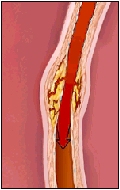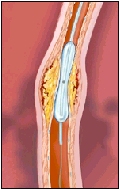Welcome to the comprehensive medical library of the Hartford Cardiology Group. The information shared below is provided to you as an educational and informational source only and is not intended to replace a medical examination or consultation, or medical advice given to you by a physician or medical professional.
If you have any questions or concerns regarding any condition or treatment, please contact the Hartford Cardiology Group. To schedule an appointment please call the Hartford Cardiology Group (860.547.1489) or use our online Request an Appointment form.
Coronary Angioplasty
Your doctor will talk to you about your heart problem and explain how angioplasty can help. Angioplasty relieves symptoms of coronary artery disease by improving blood flow to your heart.

The blood flow to the heart muscle increases.

The balloon compresses the plaque against the artery wall
- A guide wire is inserted through the guiding catheter (a thin, flexible tube) and moved to the narrow spot in your artery. Your doctor tracks its movement on anangiogram, a special kind of x-ray.
- A balloon-tipped catheter is inserted through the guiding catheter and threaded over the guide wire. It is positioned at the narrow part of the artery.
- The balloon is inflated and deflated several times to compress the plaque against the artery wall. You may feel angina (chest pain) when the balloon is inflated. Tell your doctor if you do.
- The balloon is deflated and the catheters and guide wire are removed. The artery is now open, and blood flow to the heart muscle increases.
After the Procedure
- You’ll need to remain lying down for 6-12 hours.
- If the insertion site was in your groin, you may need to lie down with your leg still for several hours.
- A nurse will check the insertion site and your blood pressure. Before going home, you may have a chest x-ray and other tests.
- You usually remain in the hospital for several hours or overnight.
Call Your Doctor If:
- You haveangina (chest pain).
- The insertion site has pain, swelling, redness, bleeding, or drainage.
- You have severe pain, coldness, or a bluish color in the leg or arm that held the catheter.
- You experience blood in your urine, black or tarry stools, or any other kind of bleeding.
- You have a fever over 101.0°F.
